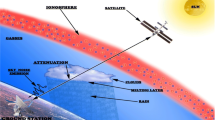Abstract
This paper presents some initial results from an experiment designed to measure microwave propagation through the bright band at 4 and 7 GHz. Preliminary measurements taken at 7 GHz indicate bright band attenuation to be many times (in dB per kilometer) greater than attenuation due to equivalent amounts of rain. These measurements also suggest that refractive multipath might occur during bright-band propagation conditions. An experimental design based on remote telemetry is described to improve resolution in future measurements and to help model bright-band propagation phenomenon.
Analyse
Cet article présente quelques résultats préliminaires d’une expérience destinée à mesurer la propagation des hyperfréquences à travers une couche isothermique 0°C à 4 et 7 GHz. Une série de premières mesures effectuées à 7 GHz indiquent que l’affaiblissement dans la couche isothermique 0°C est de plusieurs fois supérieur (en dB par km) à l’affaiblissement dû à une quantité équivalente de pluie. Ces mesures font également apparaître que des trajets multiples par réfraction peuvent survenir en propagation à travers une couche isothermique 0°C. On décrit un système expérimental basé sur la télémesure destiné à améliorer la résolution des mesures ultérieures et la modélisation du phénomène de propagation dans une couche isothermique 0°C.
Similar content being viewed by others
References
Watson (P. A.). Survey of measurements of attenuation and other hydrometeors.Proc. IEE, London (1976),123, n∘ 9, pp. 863–871.
Oomori (T.),Aoyagi (S.). A presumptive formula for snowfall attenuation of radio waves.Electr. & Communic. in Jap. (1971),54-B, n∘ 9, pp. 34–39.
Kolosov (M. A.), Poshidaer (V. N.), Sokolov (A. V.), Sukhoniu (E. V.). The prediction of millimetre radio wave attenuation in precipitation,Iurcm coll., Nice, Fr., 23–21 octobre 1973.CNET, Fr. (1973), IV-12.
McCormick (K. S.). A comparison of precipitation attenuation and radar backscatter along Earth space paths.IEEE Trans. AP, USA (1972),20, n∘ 6, pp. 747–755.
Goldhirsh (J.). Attenuation of propagation through rain for an Earth-satellite path correlated with predicted values using radar.IEEE Trans. AP, USA (1976),24, pp. 800–806.
Dissanayake (A. W.), McEwan (J. J.). Radar and attenuation properties of rain and bright band. Conf. on Antennas and Propagation.Proc. IEE, London (1978), n∘ 169, pp. 125–129.
Goldhirsch (J.). A review on the application of non attenuating frequency radar for estimating rain attenuation and space diversity performance.IEEE Trans. GE, USA (1979),17, n∘ 4, pp. 218–239.
Laws (J. O.),Parsons (D. A.). The relation of raindrop size to intensity.Trans. Amer. Geophys. Union (1943),22, pp. 452–460.
Author information
Authors and Affiliations
Rights and permissions
About this article
Cite this article
Vander Star, J.A., Kharadly, M.M. Measurements of copolar attenuation through the bright band at 4 and 7 GHz. Ann. Télécommun. 36, 48–53 (1981). https://doi.org/10.1007/BF02997003
Received:
Issue Date:
DOI: https://doi.org/10.1007/BF02997003




